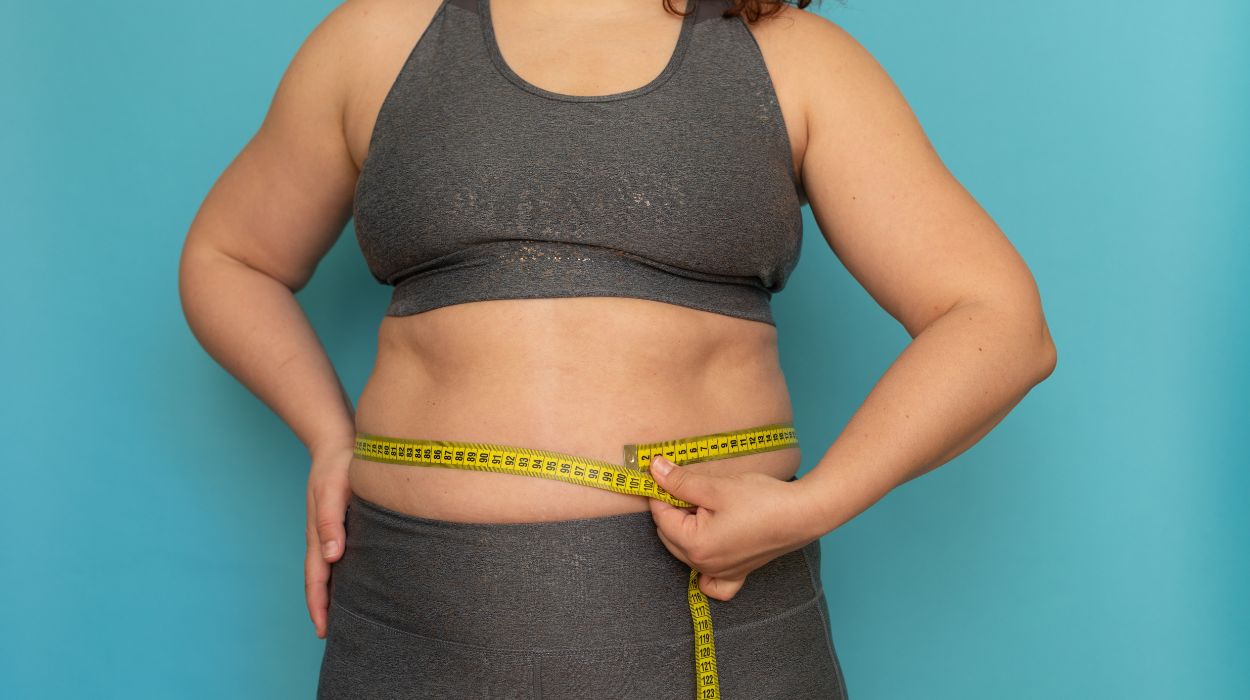It’s common for people to want to lower their body fat percentage. What they may not realize is that there are two types of body fat.[1] One type is subcutaneous body fat, which is below the surface of the skin. The other type is visceral fat, which is deeper and lines the internal organs.
When trying to lose weight, most aren’t concerned about the specific type of fat that’s being lost. People usually just want to look and feel better. However, it’s good to understand the differences between visceral versus subcutaneous fat.
Visceral fat acts differently than subcutaneous fat and is considered the more dangerous type. Having too much of it is linked[2] to type 2 diabetes and cardiovascular disease, among other health problems.
Learn strategies for visceral fat loss below, so you can improve your health. With less visceral fat, you can lower your risk of heart disease and other health problems.
How To Get Rid Of Visceral Fat: 5 Healthy Ways
- Consider a low-carbohydrate diet.
- Choose high-intensity interval training over moderate cardio.
- Increase soluble fiber intake.
- Add resistance training to your routine.
- Remain in a calorie deficit.
5 Science-Backed Ways To Reduce Visceral Fat
Visceral fat has a greater impact[2] on health than subcutaneous fat. It’s known as a metabolically active fat. This means it produces chemicals that can damage your health. Therefore, it’s important to learn how to get rid of it.
Below are some research-backed strategies for reducing excess visceral fat. There is no magic solution for getting rid of it. However, some strategies are more effective than others.
Consider A Low-Carbohydrate Diet

A low-carbohydrate, high-fat diet may be beneficial to help reduce excess visceral fat. A recent clinical study[3] found that those following this type of diet lost a significant amount of visceral fat.
In the study, a low-carb, high-fat diet was found to be more effective for losing fat. This was evident from a smaller waist circumference. This is important because visceral fat found in the abdominal cavity tends to be[2] more insulin-resistant, which comes with health risks.[4]
To improve your health, low-carb may be the way to go. In the study,[3] a low-carb, high-fat diet was defined as 8% of calories from carbs and 75% from fats. This suggests how many carbs per day will work for fat loss.
Visceral fat is particularly harmful[1] when stored in the abdominal cavity. Keep in mind that visceral fat and belly fat aren’t the same thing. However, visceral fat can be stored around the abdominal organs, leading to excess belly fat.
Choose High-Intensity Interval Training Over Moderate Cardio
If you’re trying to choose the best cardio exercise for visceral fat loss, high-intensity interval training is the top choice. One study[5] compared high-intensity interval training and sprint training workouts to moderate-intensity cardio in an obese population.
Study results found that high-intensity and sprint training resulted in the same amount of total fat loss as moderate-intensity cardio. However, people lost more visceral fat with sprinting and high-intensity interval training.
Sprinting and high-intensity interval training were both effective for reducing excess visceral fat, but there are differences between them. In the study noted above, sprint training involved maximum effort. High-intensity intervals were completed at 90% of maximum effort.
High-intensity interval training and sprint training both involve bursts of intense activity. These intense bursts are alternated with low-intensity recovery periods. You might sprint or run for 30 seconds, and then walk to recover for one minute. This process is repeated several times.
Increase Soluble Fiber Intake
Meeting daily fiber needs can help lower visceral fat in the body. This is especially true if you consume soluble fiber. A study[6] assessed a type of soluble fiber called β-glucan. It found that this fiber reduced visceral fat levels. Eating β-glucan was effective in reducing excess visceral fat among people with obesity.
The authors of the study explained that β-glucan becomes viscous in the stomach. This delays the emptying of the stomach and slows absorption. Ultimately, this leads to reduced insulin response and increased fatty acid synthesis. These processes can prevent insulin resistance and also help reduce visceral fat, such as belly fat.
You can add soluble fiber[7] to your own diet by consuming foods like fruits, oats, nuts, peas, and beans. Incorporating these foods can be a solution for how to lose visceral fat naturally. You could also use a fiber supplement if you are having trouble getting enough of it from food.
Add Resistance Training To Your Routine
Research suggests that resistance training, also called strength training, could be helpful for reducing visceral fat. A meta-analysis[8] that reviewed 34 different studies found that strength training reduced visceral fat. This was true over the medium-term and the long-term and for both middle-aged and older adults.
Strength training can be useful for achieving a healthy weight in general. One study[9] found that resistance training could increase resting metabolic rate by up to 5%. This rate is the number of calories burned per day at rest. Burning more calories effortlessly makes it easier to stay in a calorie deficit.
Through strength training, muscle mass can also be increased. This leads to more calories burned throughout the day since muscles consume more calories[10] than fat.
The increase in burning calories with strength training can help get rid of visceral fat more quickly. When you’re naturally burning more calories throughout the day, weight loss should be easier. By boosting your metabolism, you can achieve a larger calorie deficit.
Remain In A Calorie Deficit
To lose weight, you need to be in a calorie deficit. This means burning more calories than the amount consumed each day. Online calorie calculators aren’t always accurate. However, they provide an estimate of calories needed to burn each day.
Once you have an estimate of total calories burned, reduce caloric intake by eating fewer calories than the amount burned. Adding exercise can increase your calorie deficit, but food intake is also important. Even if you exercise, you can ruin a calorie deficit if you overeat.
Experts recommend[11] a calorie deficit of 500 to 750 calories a day for weight loss. So, if you burn 2,200 calories a day, you should consume 1,450 to 1,700 a day to lose weight. This may vary for each individual. Talk to a healthcare professional before making major changes to your diet.
It might be easier to stick to a calorie deficit if you ensure that you have adequate water intake. Research[12] has found that drinking water before a meal leads to lower food intake. Water can keep you full so that you can maintain your deficit without feeling hungry.
There are some specific strategies that can help you lose visceral fat in the abdominal cavity. However, you ultimately must be in a calorie deficit to lose any weight.
Creating a calorie deficit through increased exercise can be particularly beneficial for losing visceral fat. Research[13] has shown that there is a dose-response effect of exercise on visceral fat loss. This means that increasing amounts of exercise lead to increased visceral fat loss. Exercise has this effect because it creates a larger calorie deficit.
Visceral Fat And The Dangers Of It

High quantities of visceral fat leads to some serious health problems. Abdominal obesity is linked to many different health risks because of its association[14] with increased visceral fat. The health risks range from diabetes to heart issues, and even cancer risks.
Specific health problems linked[14] to visceral fat include insulin resistance, which elevates diabetes risk. Excess visceral fat also increases[14] the risk of cardiovascular problems and high blood pressure. For men, gaining visceral fat is also linked[15] to a higher risk of sleep apnea.
Visceral fat cells can cause these issues in part because they are metabolically active.[16] More specifically, they can produce hormones that lead to metabolic issues. Visceral fat is also associated with chronic inflammation which causes many other health issues.
Sometimes the risks associated with visceral fat are quite serious. Beyond harming cardiovascular health, visceral fat can increase[16] the risk of cancer. This doesn’t mean that a little extra fat suggests you’re destined to develop cancer. However, over time, you are at risk if you don’t make changes to your lifestyle.
Causes Of Visceral Fat
The body stores excess fat, including visceral fat, when a person consumes more calories than they burn. This is often a result of overeating combined with a lack of exercise.
Men seem to be more likely[17] to accumulate visceral fat when compared to women. In theory, it’s suggested that this is because male bodies have more chylomicrons,[17] a type of lipoprotein that transports dietary triglycerides.
Genetic factors also contribute[18] to fat storage and distribution. So, some people may be more likely to have visceral fat based on genetics. For example, Asians tend to have higher levels of visceral fat than Europeans. African Americans have less visceral fat, on average, compared to Europeans.
Even with genetic risks, it’s possible to maintain a healthy weight. How the body stores fat can be influenced by genetics. However, lifestyle factors still play a role in overall health and fat distribution.
How To Tell If You Have Visceral Obesity?
It’s not always straightforward to determine if you have visceral obesity. In general, the belly grows bigger[17] as someone accumulates more visceral fat. However, waist measurement alone is an inaccurate predictor of visceral fat, especially for women.
The best way to tell if you have visceral obesity is to see a doctor. They can recommend or refer you for a scan to measure visceral fat levels.
If you have experienced excessive weight gain around the belly, it might be time to see a doctor. They can assess whether you have excess visceral fat and related health problems.
If you’re already experiencing health problems, such as high blood sugar or blood pressure, you may have high visceral fat. However, that isn’t a sure predictor, and you should take a precise measurement. This will determine how much visceral fat you have so you aren’t left guessing.
How To Measure Visceral Fat
It’s not easy to measure visceral fat at home. Calculating body mass index or taking a waist measurement isn’t really an accurate[19] way to measure visceral fat.
It’s possible to estimate visceral fat levels by calculating a waist-to-height ratio. This still isn’t entirely precise, though.
Knowing overall body fat percentage also won’t provide an exact visceral fat reading, either.
The gold standard[19] for measuring visceral fat is a CT or MRI scan. Bioelectrical impedance analysis (BIA), which is cheap and readily available, has been found ineffective for measuring visceral fat levels. While you can probably find BIA devices at most gyms, it’s best to stick with the gold standard for an accurate reading. It will probably require extra effort, but without it, you might get an invalid result.
Contact your healthcare provider to determine how much visceral fat you have.
Conclusion
Visceral fat comes with health risks, like a higher likelihood of heart disease and diabetes. Fortunately, you can lose it through diet and exercise. There might be genetic factors that increase your tendency to store visceral fat. However, healthy lifestyle habits can help overcome genetics, even if you feel like you didn’t hit the genetic lottery.
With excess fat, exercising and being mindful of your diet will help you improve your health. You will need to watch your calorie intake and make sure you’re not overconsuming. Exercise helps you burn more calories to keep you in a calorie deficit for fat loss.’
If you have too much visceral fat and can’t lose it, talk with a doctor or dietitian. They can work with you to develop a healthy diet and exercise plan to help reduce visceral fat.
Frequently Asked Questions
Visceral fat is not considered difficult to lose. Anyone can lose excess visceral fat through proper diet and exercise.
There are several options to burn visceral fat. For one, visceral fat loss occurs when a person eats in a calorie deficit. This means eating fewer calories compared to what the body burns. Exercise can also help increase the amount of calories burned.
There is not one specific food that magically burns visceral fat. Rather, focus on eating in a calorie deficit. Foods like fruits and nuts can help with visceral fat loss because they contain soluble fiber, which keeps you full.
Yes, research[20] has shown that protein supplementation combined with a low-calorie diet helps with visceral fat loss. Consider eating a high-protein diet while keeping a calorie deficit to improve results.
 Evidence Based
Evidence Based
